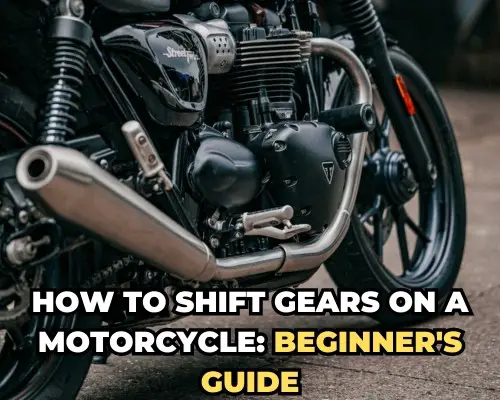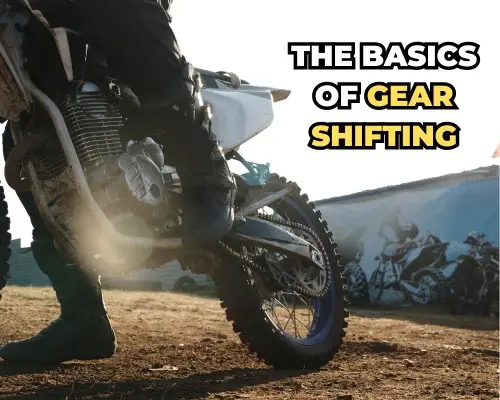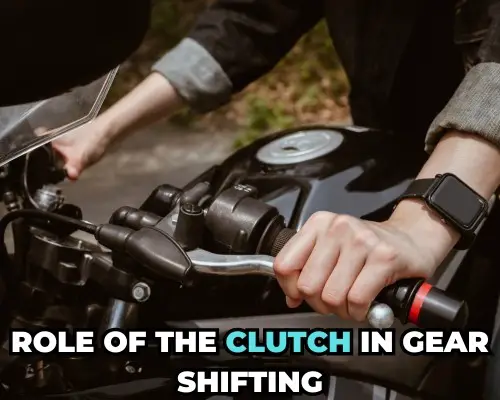Shifting gears on a motorcycle isn’t just about speed. It’s an art. Many beginners believe it’s as simple as flicking a lever. It’s not. Proper gear shifting ensures smooth rides and protects the engine.
Are you constantly jerking forward with each shift? Or hearing that ominous grinding noise? These are signs of improper technique.
This guide demystifies gear shifting. It addresses common fears and mistakes. You’ll learn the when and the how. Remember, mastering gears doesn’t happen overnight.
But understanding the basics is the first step. Ready to shift gears without second-guessing? Let’s dive into the mechanics, minus the jargon. By the end, shifting will feel like second nature.
How to Shift Gears on a Motorcycle: (Even Grandma Can Do It!)

Understand the Components: The Symphony of Control
Grasping your motorcycle’s controls is like learning an instrument. The clutch lever, your left hand’s partner, is the bridge between power and silence.
The gear shift lever, under your left foot, plays the notes of speed. Your right hand’s throttle? It conducts the engine’s roar.
Most bikes dance to a “1-down, 4-up” or “1-down, 5-up” rhythm. Knowing this melody is the first step to harmony on the road.
Start from a Dead Stop: First Notes
Remember that shaky feeling on your first bike ride? We’ve all been there. But starting from a stop can be smooth sailing once you break it down.
So, how do we get rolling?
- Clutch In: Pull the clutch lever all the way in with your fingers.
- Find First: With your left foot, press the shifter down once. You should feel a solid “clunk” – that’s first gear engaged!
- Feel the Bite: Slowly release the clutch lever with your fingers. As you do, you’ll feel the engine start to resist a little – that’s the “bite” point.
Here’s the cool part: This bite point is where the magic happens. It’s the sweet spot between the engine engaging and the motorcycle wanting to move forward.
Shifting Up and Down: The Dance of Speed
Ever wondered what those cryptic numbers on your motorcycle’s shifter mean? They’re not a secret code for aliens, but a simple way to understand how many gears your bike has. Let’s break it down, just like those confusing wheel sizes on touring bikes!
Now, the numbers on your shifter tell you two things:
- 1-down: This means pushing the shifter pedal down once shifts you into first gear.
- 4-up (or 5-up): This is the total number of gears on your motorcycle. So, 4-up means you have four gears in total (including first), while 5-up means you have five.
Think of it like this: on a 4-up bike, you have four rungs on your ladder – first gear being the bottom rung and fourth gear being the top. With a 5-up bike, you have an extra rung at the top for even faster cruising!
Neutral Gear: Finding Peace
Think of neutral as your motorcycle’s chill zone. It’s the in-between spot where the engine is running but the power isn’t connected to the wheels. This is perfect for situations like waiting at a stoplight or chatting with a fellow rider without the bike wanting to lurch forward.
Finding neutral is all about feel:
- Clutch In: Just like starting from a stop, pull the clutch lever all the way in with your fingers.
- Gentle Dance: With your left foot, lift the shifter pedal slightly. You might feel a little resistance as you move through the gears.
- The Sweet Spot: Keep lifting slowly. There’s a specific point where the shifter feels lighter and a tiny click might happen – that’s neutral!
Here’s the trick: Don’t force it! If you can’t find neutral right away, don’t keep grinding at the shifter. Just release the clutch lever slightly, regrip, and try again with a gentle lift. It’s all about finding that sweet spot where the gears line up perfectly.
Bonus Tip: On some motorcycles, you can also find neutral by slightly rocking the bike back and forth while holding the clutch in. This slight movement can help the gears align for a smoother transition.
Practice: The Path to Mastery
Gear shifting is an art and science, demanding practice and patience. Start with short journeys, expanding your horizons as confidence blooms.
Over time, your motorcycle becomes an extension of you. You’ll learn its whispers, its shouts, and everything in between. The right moment to shift will become as clear as the road ahead.
Next Step in Gear Shifting – Mastering the Art

Changing gears on a motorcycle is similar to playing an instrument; both require harmony in terms of movement and sound. Now let’s explore the gear-shifting symphony in more detail.
Step-by-Step Guide to Shifting Gears: The Dance of Mechanics
Close the Throttle: You’re on a serene highway, the wind is your companion, and you decide to slow the pace. Gently rolling off the throttle is like lowering the volume on your favorite tune, preparing for the next note.
Engage the Clutch: Pulling in the clutch is a moment of quiet in the conversation between you and your bike. It’s a brief pause that prepares both of you for the next gear, much like drawing in a breath before speaking.
Select a Gear: This is where you and your motorcycle start to communicate. Whether you’re pressing down or lifting on the shift lever, each click is a word in the language of riding. It’s a tactile feedback loop that says, “We’re in this together.”
Release the Clutch and Roll on the Throttle: The crescendo of our symphony. You are producing momentum, a fluid acceleration that makes the bike feel like an extension of your body, as you smoothly combine the release of the clutch with a light throttle roll.
Common Mistakes and How to Avoid Them: Lessons from the Road
Slamming the Clutch or Throttle: Remember my first long ride? I was eager, maybe too eager, and my abrupt clutch work showed it.
The bike lurched, rebelling against my heavy hand. The lesson? Treat the controls like you’re handling a delicate instrument because, in many ways, you are.
Ignoring the Engine’s Voice: On one of my early rides, I was so focused on the road that I ignored the rising whine of the engine—a clear sign I was overdue for a shift.
It’s like missing the cue in a song, where you’re supposed to come in with the chorus but you miss the beat. Listen to your bike; it’s always communicating.
Hesitation: During my first ride in heavy traffic, hesitation had me stalling more than moving. Like stumbling over your words in a speech, hesitation on the shift can jolt the smooth flow of your ride. Confidence grows with practice, turning once jerky motions into fluid movements.
Enriching Your Gear Shifting Skills: Beyond the Basics
Shifting gears smoothly is more than a technical skill; it’s a bond between rider and machine. Each ride is a new verse in your ongoing story. Here are a few tips to deepen that connection:
Embrace the Journey of Learning: Every ride is a lesson. Cherish the early stumbles; they’re invaluable teachers.
The Symphony of Riding: Your motorcycle’s sounds and vibrations are music. Learn to play in harmony with them, and you’ll find the sweet spot for each gear shift.
Patience is Your Ally: Rushing through gears can lead to a discordant ride. Embrace patience, and you’ll find your riding experience becomes richer and more enjoyable.
Shifting gears involves more than just altering speed; it involves establishing a smooth communication channel with your motorcycle.
This conversation becomes second nature with practice, a reflection of the strong bond developed over innumerable rides.
Keep practicing, listening, and learning, and the road will become your canvas, painted with the brushstrokes of your journeys.
The Role of the Clutch in Gear Shifting: Fine-Tuning Your Ride

The clutch, an unassuming lever on your left, holds the secret to a motorcycle’s soul. It’s not just a component; it’s your intimate link to the heart of your bike, the gateway to a symphony of power and speed. Let’s dive deeper, beyond the mechanics, into the art of clutch control.
The Clutch: Your Dance Partner in Gear Shifting
- The Essence of Clutch Engagement: Picture this: a cool morning, the road ahead empty and inviting. You’re about to set off, and your hand reaches for the clutch. This isn’t just a routine movement; it’s the beginning of a dialogue with your motorcycle.
The moment you pull that lever, you’re asking the engine to momentarily hold its breath, allowing you to choose your pace, your gear, and your journey. It’s a pause filled with possibilities.
- Gear Shifting: A Choreographed Movement: Changing gears with the clutch disengaged is like finding the rhythm in a dance. There’s a click, almost imperceptible, a sign you’ve communicated well.
I remember the first time it clicked for me—literally. It was a moment of pure clarity, a small victory in my riding journey. Each shift became a step, each ride a dance.
- The Art of Clutch Release: Releasing the clutch and rolling on the throttle is where finesse comes into play. My mentor once said, “It’s like pouring a fine wine. Too fast, and you spill; too slow, and you lose the essence.” He was right.
There’s a grace in finding that balance, a thrill in executing it perfectly. It’s a skill honed over countless rides, each one a lesson in precision.
Mastering Clutch Control: Beyond the Basics
- The Practice Ground: Mastery comes with practice, but not just any practice. It’s about intentional, focused repetitions. Each engagement of the clutch, each shift, should be deliberate.
I learned this the hard way, stalling more times than I care to admit in a crowded parking lot. Yet, with each mistake, I found a better understanding of my bike, and a deeper connection.
- Discovering the Biting Point: The biting point is a motorcycle’s whisper to you. It’s where potential becomes motion. Finding it is a milestone.
I still remember the exhilaration of that discovery, the way my bike seemed to nod in approval. This point is unique to each motorcycle, a secret between rider and rider.
- The Clutch as a Tool for Refined Control: Using the clutch for subtle speed adjustments became my secret weapon, especially in traffic or on twisty roads.
It’s like having a nuanced conversation in a noisy room, where slight gestures convey volumes. Learning this language of slight pulls and releases transformed my riding experience.
Navigating Common Mistakes: Wisdom from the Road
- The Temptation of Coasting and Clutch Riding: Coasting seemed harmless at first, a brief respite on long rides. Yet, I quickly learned it was akin to walking with your eyes closed—risky and unnecessary.
Similarly, clutch riding, a habit I picked up in traffic, proved to be a silent killer of clutch plates. Both habits were hard to break, but essential for the longevity of my ride.
- The Risk of Clutch-less Shifting: Skipping the clutch felt like a shortcut, a trick to keep pace with more experienced riders. However, it didn’t take long to realize the toll it took on my motorcycle’s gearbox.
The harsh lesson came in the form of a hefty repair bill. True skill, I learned, lies in the proper use of the clutch, not in circumventing it.
Gaining control over the clutch is like mastering the language of your motorcycle; every little movement and nuance brings you one step closer to harmony on the road.
It’s a trip that is full of difficulties as well as exuberant and meaningful moments. Recall that every rider has a different journey with their own set of successes and setbacks. Embrace yours, clutch lever and all.
Shifting Gears in Different Riding Conditions – A Rider’s Harmony

Navigating through the ever-changing landscapes and tempos of the road requires more than just technical skill; it’s about crafting a bond with your motorcycle, where gear shifting becomes an intuitive dance. Let’s enrich our journey with a deeper understanding and some tales from the road.
City Riding vs. Highway Touring: A Tale of Two Rhythms
- The Pulse of the City: City Riding, with its symphony of stoplights and crosswalks, taught me the value of vigilance and adaptability.
Each gear shift is a response to the immediate; a quick downshift prepares you for sudden halts, while a timely upshift gets you ahead of the urban flow.
I recall navigating through narrow streets, where the constant play between first and second gear felt like a delicate ballet, each move calculated yet fluid.
- Cruising the Open Highway: The open road is where the soul stretches its legs. Here, the engine hums a steady tune, and gear shifts are fewer but monumental.
I learned to listen to my bike’s heartbeat, finding that optimal gear that resonates with the horizon’s call.
It’s about settling into the ride, where the rhythm of the road and the hum of the engine synchronize into a blissful melody.
Mastering Hills: The Ascent and Descent Symphony
- Uphill Serenades: Climbing hills on a motorcycle is reminiscent of a challenging ascent in life—daunting yet rewarding. The trick lies in anticipation.
I remember approaching a particularly steep hill, downshifting early to maintain momentum without overstraining the engine.
It’s like catching a breath before diving underwater, a preparation that makes the climb seamless and empowering.
- The Downhill Cadence: Descending, however, is a different kind of dance. Utilizing engine braking rather than relying solely on brakes taught me control and preservation.
There’s a harmony in descending with the same gear you ascended, a balance that feels like gliding down with a parachute.
The first time I mastered this technique, the bike and I moved as one—confident, controlled, and exhilaratingly free.
Touring: The Long, Reflective Ballad
Touring by motorcycle is akin to writing a long, reflective ballad; it’s where you find your riding rhythm and truly get to know your bike.
I discovered the importance of selecting a gear that allows for a cadence of comfort and efficiency, reducing the need for constant shifting.
It’s about embracing the journey, where each mile is a note in your melody. On one long stretch, I found myself in perfect harmony with my motorcycle, the landscape blurring into a canvas of colors and sensations, a reminder of why I ride.
The Essence of Adaptability
Riding through varied conditions has taught me that gear shifting is much more than a mechanical necessity; it’s a dynamic interplay between rider and machine, adapting to the song of the road.
Whether it’s the quick, staccato shifts of city navigation, the long, sustained notes of highway travel, or the crescendos and decrescendos of hill riding, each requires a keen sense of timing, intuition, and a deep connection with your motorcycle.
As an Amazon Associate, I earn from qualifying purchases, at no additional cost to you. Read Our Affiliate Disclosure.

